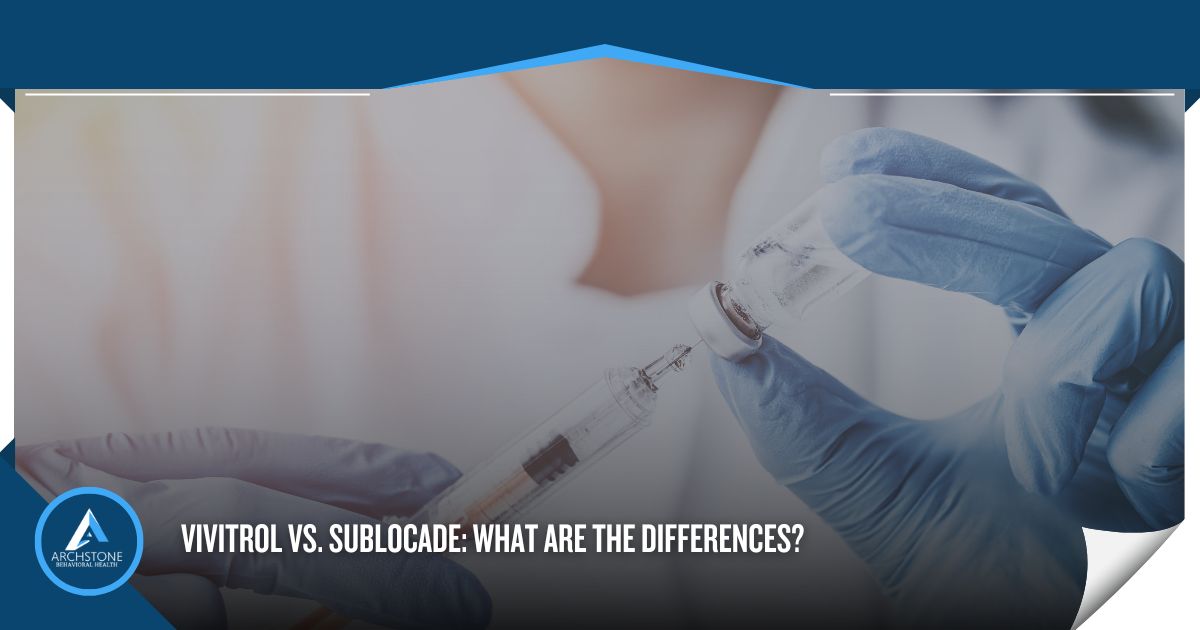Vivitrol vs. Sublocade: What Are the Differences?
Get Help Now

The pleasurable effects of opioids may make people want to use them more often. People who use opioids a lot may develop physical dependence or addiction to them. Opioid addiction can cause serious complications. It may become life-threatening if people do not receive substance use disorder treatment.
People with opioid use disorders often take medications to help them reduce withdrawal symptoms and stabilize brain chemistry. Taking medications may also help people avoid relapse during treatment. Two of the most common drugs used to treat opioid use disorders are Sublocade and Vivitrol.
But what is the difference between Vivitrol and Sublocade? Knowing how both medications work can help you make informed choices about your addiction treatment plan.
This article will outline some of the most important differences between Vivitrol and Sublocade. If you or someone you love struggles with opioid addiction, contact the Archstone Recovery specialists to learn about our effective treatment programs. You may also schedule an intake assessment.
What is Sublocade?
Sublocade is a name-brand drug. It contains an active ingredient called buprenorphine. Buprenorphine is a partial opioid agonist. This means that it works in a similar way to opioids in the body.
Sublocade is only used to treat opioid use disorders. People who take Sublocade receive a monthly injection of buprenorphine.
The extended-release injection goes under the skin, usually on a person’s abdomen. Once a medical professional places the medication under the skin, it turns into a solid, gel-like substance. Then, the medication enters the bloodstream in small amounts for a month.
People may begin using Sublocade after taking oral buprenorphine for seven days. People who take Sublocade do not have to remember to take medication every day. This can reduce non-compliance during treatment.
Sublocade has the potential for physical dependence. People may experience withdrawal symptoms if they suddenly stop taking it.
Using Sublocade can help people maintain abstinence from opioids. Counseling and ongoing support are also crucial for long-term recovery.
What is Vivitrol?
Vivitrol contains naltrexone, an opioid antagonist. This means that it blocks the effects of opioids. Medical professionals may prescribe Vivitrol to people with opioid use disorders or to treat those with alcohol use disorders.
People who use Vivitrol receive a monthly injection. The injection goes into the muscle, usually in the buttocks. People may begin using Vivitrol after a complete detoxification. If people take Vivitrol before all opioids are cleared from their bodies, they may experience opioid withdrawal.
Vivitrol is not habit-forming or physically addictive. People may take Vivitrol to maintain abstinence from opioids or alcohol. Counseling and support are also crucial to preventing relapse.
What are Sublocade and Vivitrol Used For?
Medical professionals prescribe Sublocade and Vivitrol during medication-assisted treatment (MAT) programs. According to the Substance Abuse and Mental Health Services Administration (SAMHSA), medication-assisted treatment programs are effective at treating opioid use disorders. Doctors may also prescribe Vivitrol for patients going through alcohol abuse treatment.
Medication-assisted treatment programs also include emotional support, supervision, and holistic therapies. Addiction treatment facilities offer MAT treatment programs in inpatient and outpatient settings.
What Are the Side Effects of Sublocade and Vivitrol?
Like all medications, Sublocade and Vivitrol can cause side effects. These effects may be mild or severe.
Side effects of Sublocade
Common side effects of Sublocade include:
- Constipation
- Headache
- Itching or discomfort at the injection site
- Nausea
- Vomiting
- Tiredness
Some of the severe side effects of Sublocade may include:
- Allergic reaction
- Liver problems, including hepatitis
- Low blood pressure when changing positions
You must discuss the benefits and risks of Sublocade with your doctor before beginning treatment.
Side effects of Vivitrol
Common side effects of Vivitrol include:
- Common cold
- Headache
- High blood pressure
- Itching or discomfort at the injection site
- Toothache
- Difficulty sleeping
Some of the severe side effects of Vivitrol may include:
- Allergic reaction
- Depression
- Suicidal thoughts and behaviors
- Liver problems, including hepatitis
- Pneumonia
- Severe pain, swelling, or hives at the injection site
Talk to your doctor about the benefits and risks of Vivitrol before you begin taking it.
Learn More About Sublocade and Vivitrol
People with opioid use disorder may benefit from medication-assisted treatment using Sublocade or Vivitrol. There are benefits and risks of using these and other medications. Before starting an MAT program, your doctor or an addiction specialist will evaluate your needs. This evaluation will determine if treatment with Sublocade or Vivitrol may help you.
Opioid addiction is a complex condition that requires comprehensive treatment. Contact the specialists at Archstone Recovery now to learn about our substance use disorder treatment programs. You may also schedule an intake assessment.